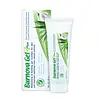What's inside
What's inside
 Key Ingredients
Key Ingredients

No key ingredients
 Benefits
Benefits

 Concerns
Concerns

No concerns
 Ingredients Side-by-side
Ingredients Side-by-side

Water
Skin ConditioningButylene Glycol
HumectantDipropylene Glycol
HumectantGlycerin
HumectantNiacinamide
Smoothing1,2-Hexanediol
Skin ConditioningCentella Asiatica Extract
CleansingAcrylates/C10-30 Alkyl Acrylate Crosspolymer
Emulsion StabilisingEthylhexylglycerin
Skin ConditioningTromethamine
BufferingAllantoin
Skin ConditioningXanthan Gum
EmulsifyingDipotassium Glycyrrhizate
HumectantZinc PCA
HumectantPanthenol
Skin ConditioningOctyldodeceth-16
EmulsifyingHydroxypropyltrimonium Hyaluronate
Hydrolyzed Hyaluronic Acid
HumectantAdenosine
Skin ConditioningSodium Hyaluronate
HumectantDisodium EDTA
Tocopherol
AntioxidantHydrolyzed Sodium Hyaluronate
Skin ConditioningMadecassic Acid
Skin ConditioningAsiaticoside
AntioxidantAsiatic Acid
Skin ConditioningWater, Butylene Glycol, Dipropylene Glycol, Glycerin, Niacinamide, 1,2-Hexanediol, Centella Asiatica Extract, Acrylates/C10-30 Alkyl Acrylate Crosspolymer, Ethylhexylglycerin, Tromethamine, Allantoin, Xanthan Gum, Dipotassium Glycyrrhizate, Zinc PCA, Panthenol, Octyldodeceth-16, Hydroxypropyltrimonium Hyaluronate, Hydrolyzed Hyaluronic Acid, Adenosine, Sodium Hyaluronate, Disodium EDTA, Tocopherol, Hydrolyzed Sodium Hyaluronate, Madecassic Acid, Asiaticoside, Asiatic Acid
Water
Skin ConditioningPropylene Glycol
HumectantAloe Barbadensis Leaf Extract
EmollientCarbomer
Emulsion StabilisingPhenoxyethanol
PreservativeCucumis Sativus Fruit Extract
EmollientSodium Hydroxide
BufferingButylene Glycol
HumectantChlorphenesin
AntimicrobialDisodium EDTA
Glycerin
HumectantCentella Asiatica Extract
CleansingAloe Barbadensis Leaf Juice
Skin ConditioningMaltodextrin
AbsorbentPhosphoric Acid
BufferingSodium Benzoate
MaskingSodium Carbonate
BufferingPotassium Sorbate
PreservativeSodium Sulfite
PreservativeWater, Propylene Glycol, Aloe Barbadensis Leaf Extract, Carbomer, Phenoxyethanol, Cucumis Sativus Fruit Extract, Sodium Hydroxide, Butylene Glycol, Chlorphenesin, Disodium EDTA, Glycerin, Centella Asiatica Extract, Aloe Barbadensis Leaf Juice, Maltodextrin, Phosphoric Acid, Sodium Benzoate, Sodium Carbonate, Potassium Sorbate, Sodium Sulfite
Ingredients Explained
These ingredients are found in both products.
Ingredients higher up in an ingredient list are typically present in a larger amount.
Butylene Glycol (or BG) is used within cosmetic products for a few different reasons:
Overall, Butylene Glycol is a safe and well-rounded ingredient that works well with other ingredients.
Though this ingredient works well with most skin types, some people with sensitive skin may experience a reaction such as allergic rashes, closed comedones, or itchiness.
Learn more about Butylene GlycolCentella Asiatica Extract (Centella) is derived from an herb native to Southeast Asia. It is famous for its anti-inflammatory and soothing properties.
Centella is rich in antioxidants and amino acids, such as Madecassic Acid and Asiaticoside.
Studies show the compounds in centella help with:
The combination of all these properties makes centella effective at soothing, hydrating, and protecting the skin.
Other great components of centella include Vitamin A, vitamin C, several B vitamins, and Asiatic Acid.
Fun fact: Centella has been used as a medicine and in food for many centuries. As a medicine, it is used to treat burns, scratches, and wounds.
Learn more about Centella Asiatica ExtractDisodium EDTA plays a role in making products more stable by aiding other preservatives.
It is a chelating agent, meaning it neutralizes metal ions that may be found in a product.
Disodium EDTA is a salt of edetic acid and is found to be safe in cosmetic ingredients.
Learn more about Disodium EDTAGlycerin is already naturally found in your skin. It helps moisturize and protect your skin.
A study from 2016 found glycerin to be more effective as a humectant than AHAs and hyaluronic acid.
As a humectant, it helps the skin stay hydrated by pulling moisture to your skin. The low molecular weight of glycerin allows it to pull moisture into the deeper layers of your skin.
Hydrated skin improves your skin barrier; Your skin barrier helps protect against irritants and bacteria.
Glycerin has also been found to have antimicrobial and antiviral properties. Due to these properties, glycerin is often used in wound and burn treatments.
In cosmetics, glycerin is usually derived from plants such as soybean or palm. However, it can also be sourced from animals, such as tallow or animal fat.
This ingredient is organic, colorless, odorless, and non-toxic.
Glycerin is the name for this ingredient in American English. British English uses Glycerol/Glycerine.
Learn more about GlycerinWater. It's the most common cosmetic ingredient of all. You'll usually see it at the top of ingredient lists, meaning that it makes up the largest part of the product.
So why is it so popular? Water most often acts as a solvent - this means that it helps dissolve other ingredients into the formulation.
You'll also recognize water as that liquid we all need to stay alive. If you see this, drink a glass of water. Stay hydrated!
Learn more about Water